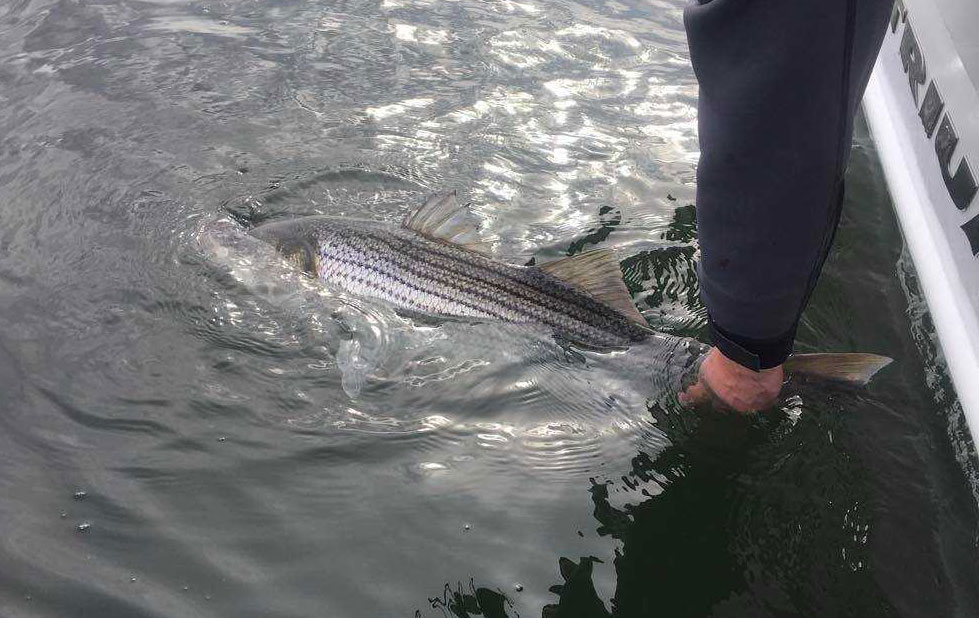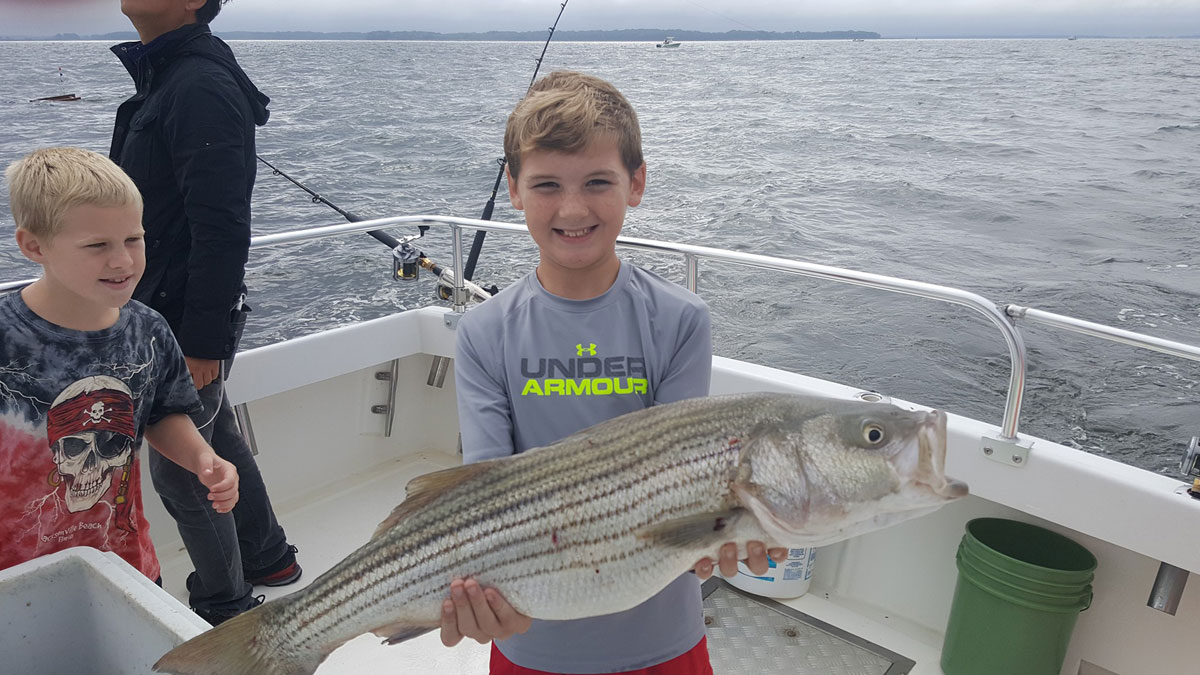Lower Chesapeake Bay Fishing Report 11/24/2017 Update:
Happy Thanksgiving from all of us at FishTalk! Heavy winds put the brakes on the action early this week, but now that they've calmed down it's time to spring into action - late fall fishing is in full swing. J&W reported that trolling has been the hot option lately, as the majority of trollers have been catching the most and largest fish. Red hoses, Tsunamis, and bucktails pulled along channel edges have been the best option, producing fish in the upper twenties and low thirties. J&W reported that hot spots have been the Potomac (from St. George's Island on down) and outside the Patuxent up to the Cove Point area along the channel edges, where large fish have been abundant.
While there hasn't been a huge influx of ocean-run fish just yet, some bigger stripers in the mid-30-inch class have been showing up in the catches. Anglers are reporting that those switching to larger spring-style baits and umbrella rigs are having the most luck finding these bigger fish. Jiggers have picked up a few big fish too, but the majority of the catch for those slinging soft plastics has been in the 20 to just-over-30-inch range. White, pearl, and chartreuse have all been productive colors and using pink/white or chartreuse/orange skirted heads has been a good move lately. The location of the fish is sometimes given away by birds, and sometimes it takes some hunting to find them on the fishfinder. In both cases the larger, more active fish have been located from mid-depth down to the bottom in 25' to 40' of water, so let those jigs sink five or 10 seconds before you begin the retrieve.
Lower Chesapeake Bay Fishing Report 11/17/2017:
The Lower Bay has been experiencing a great November, as baitfish have been moving out of tidal rivers and down the Bay, bringing plenty of 20- to 30-plus-inch rockfish with them. The mouths of the Patuxent and Potomac have been the most productive rivers according to J&W, and most anglers have been vertical jigging. Stick with the northern shore between St. George's and Point Lookout, and look to find fish along the drop-offs. The Tackle Box suggested using white, chartreuse, or pearl soft plastics, as they have been the best colors so far. The southern shore of the Potomac from Lewisetta down to Smith Point and the mouth of the Rappahannock have also been producing some fish.

Trollers working the open Bay's channel edges with tandem rigs, small umbrella rigs, red hoses, and Tsunamis have been catching some fish, but the good fishing in the mouth of the Potomac has had most anglers pulling short instead of making the longer runs. That said, a decent grade of fish is in the open Bay with many in the mid-20s to 30 inches, sometimes under birds. The giant migratory fish haven't showed up yet in Maryland waters, but the Tackle Box has heard of a few from the CBBT and the mouth of the Chesapeake. Their numbers haven't been huge and the main body of fish still seems to be up north near Jersey, but some of these bigger fish could turn up anywhere in the Lower Bay in the coming weeks so it may be time to consider mixing a few larger nine- or 10-inch parachutes and plastic shad into your spread.
White perch fishing has been stellar in most rivers, particularly around structure and hard bottom at the river mouths in 25' to 35' of water. Bloodworms on bottom rigs are the top producer. There's also good perch fishing to be found up inside in the Patuxent, near the route four bridge.
Lower Chesapeake Bay Fishing Report 11/10/2017:
Reader Note: See the Middle Bay report for an 11/13 update on current striper patterns in the Chesapeake.
Cold weather has stunted some of the previously productive fisheries in the Lower Bay, however some hotspots have continued to produce fish this week. Ceder Creek, Drum Point, and the mouth of the Patuxent have all been hotspots, and are producing decent sized fish. The mouth of the Potomac in general has continued to be productive, especially along channel edges from 15 to 25 feet, stretching from St George's down. The Tackle Box said they're looking for fish to begin moving out of rivers and into the bay to migrate south, however this hasn't began to take place down south just yet. The Tackle Box did have some interesting reports from anglers trolling the Potomac who have had large blue catfish mixed in with their bite. Trolling. Catfish. Um... okay!
Trollers working the channel edges of the open Bay are also finding some fish, but the bite hasn't been red hot. Tsunamis, Sassy Shad, and small umbrellas are still top picks and white has been out-fishing other colors. There have also been schools of fish under birds throughout the area, however, generally speaking when you've found working fish they have been on the small side.
Lower Chesapeake Bay Fishing Report 11/2/2017:
The Lower Bay remains full of life as we move into the "cooler" months, even though it hasn't been much cooler thus far. Although many species have left the bay area, rockfish have remained and are providing an active fishery. J&W reports that small to mid-sized rockfish have been hanging out in all local rivers, chasing small baitfish, however some fish upwards of 25 inches are being caught in the Potomac, and down around the CBBT. Most larger fish have been caught by anglers fishing close to bottom, typically on 1/2 ounce jig heads with pearl soft plastics.

The Tackle Box has had some reports of anglers trolling and catching fish in a larger class, primarily in the Potomac and along channel ledges. The area from St. George's Island down to Point Lookout remains a good bet. Smaller rock can be located by chasing birds, and for anglers willing to sort through the little ones, it can be well worth the time spent. When birds aren't active jiggers and trollers working the edges from 18' to 25' have been catching fish.
Trollers have also been finding success near Cove Point, and along the eastern shore channel edges. Tsunamis, parachutes with paddle tails, and red hoses have all been effective lures. Relatively small baits in the four to six inch range are still working best, and we haven't heard of any large sea-run stripers showing up just yet. In fact, Angler in Chief Lenny Rudow talked with a Long Island, NY charter captain on Thursday, who said that all the way up in New York, the big stripers hadn't even started pushing south just yet. So while the schoolie bite remains strong, we may not see those big sea-run fish for a while.